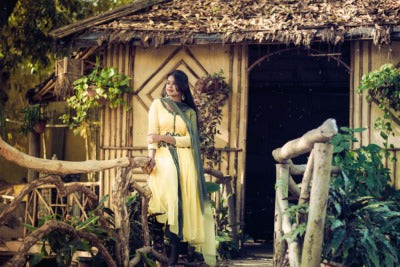
Indigenous traditions and tribes:
roots of sustainability
Clothing , together with architecture and cuisine, represents perhaps one of the oldest art forms . Clothing, in addition to offering us protection and shelter, has transformed over time into a means of communication. Through clothes we talk about ourselves, who we are, who we would like to be. Our way of dressing represents a language capable of telling one, a hundred, a thousand stories : a tool of non-verbal expression, which like art has become universal, speaking directly to the senses and therefore to all human beings. This is how fashion was born, through the origin of new and different styles, which different groups, in a constantly evolving society, use to communicate their identity, their adherence to certain cultural values . Today fashion is a way of celebrating the diversity and variety of the world we live in, but also a mirror in which we can reflect, a way to bring changes to society and give continuity to life on Earth.
This is perhaps why sustainability is increasingly widespread . We find ourselves living in a society that offers garments produced in the same factory, by the same hands, at completely different prices, destined for opposite segments: on the one hand the mass market and on the other the luxury market. And this indicates a serious problem. Fast fashion tramples workers' rights and identifies itself as a model that is no longer sustainable . It is therefore necessary to look at new examples and profit from them, in order to create greater balance at a global level. A dilemma that could find a valid answer in those corners of the planet where globalization has not yet produced its effects , from emerging markets to indigenous tribes.
Africa is the first case to keep our eyes on : the continent with the youngest population in the world, with 60% of individuals under the age of twenty-five, has a rapidly growing middle class and many really interesting traditional practices. Barkcloth is a very widespread textile technique in Uganda : the fabric obtained, of rare beauty, colored and decorated, is still used today for important ceremonies. It is obtained from the fibers of some plants of the Moraceae family and is obtained by gently beating the bark until it becomes thin and elastic. That's why emerging designer Juliana Nasasira presented her collection using this traditional material at Kampala Fashion Week . And there is no shortage of other types of textiles from Nigeria and Ghana, or the traditional Berber weaving in North Africa, finishing with the artisanal pearls of the Masai and Ndebele ethnic groups, which could play a central role in the revitalization of the fashion industry in the aftermath of the COVID-19 crisis.

But indigenous design from the American continent also plays a fundamental role in the sustainability sector . Artists who face the process of creation, becoming custodians of ancient knowledge coming from their ancestors, thus safeguarding the fragile ecosystem in which they are immersed. These communities take an ecological approach to using locally sourced leather and fabrics, creating small collections to order and reusing waste or old objects to convert them to new life . Orenda Tribe is an eco-conscious brand that focuses on reused and recycled vintage items, born from the idea of Amy Yeung, an indigenous creative who launched her brand after leaving her career in the fast fashion world. Urban Native Era , through the power of storytelling, uses design, film and photography to empower collective change by drawing inspiration from ecological production. Section35 instead aims to combine indigenous art, culture and lifestyle in a streetwear brand attentive to an authentic representation of the world. OXDX, thanks to teachings handed down for generations, eliminates waste with upcycling programs that allow us to offer personalized clothing.
But sustainable fashion also touches India . More and more conscious brands recognize the need to make various aspects of design and operation more relevant to the environment and the local workforce . Soham Dave uses natural ingredients to dye and purify their fabrics. The Kaleekal brand uses manual and traditional looms in order to attract the most demanding buyers; and to minimize industrial waste it uses natural fabrics. Bhu: Sattva , finally, is leading a quiet revolution in India with organic cotton made in Gujarat; and is expanding research and development to blend fabrics made from banana, bamboo, soy and silk fibers.
In short, although practiced in different forms, fashion exists in almost all cultures and can be considered a distinctive peculiarity of the human species . Even in its most primitive forms, it responds to certain universal needs, such as individual and group survival, as well as existential questions. All that remains is to hope for a movement that is increasingly aware and attentive to the true needs of our existence. In this sense , fashion must increasingly be narration through clothing; telling the stories behind and around our garments to become a cultural influence and point of contact with what we wear .


